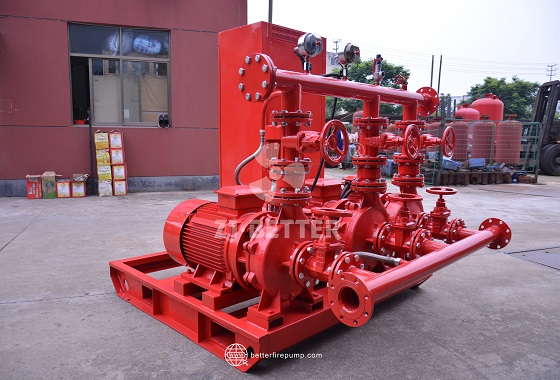In emergency firefighting operations, fire pumps serve as critical equipment and must deliver efficient and stable performance. To ensure the safety of high-rise buildings, industrial facilities, and other high-risk areas, a reliable fire pump system is essential.
1. High-efficiency performance ensures firefighting efficiency
One of the most important characteristics of a fire pump system is its high efficiency. During the critical moments of fire suppression, fire pumps must have sufficient power to deliver strong water flow and pressure, ensuring that fire extinguishing agents can quickly and effectively cover the fire source area. High-efficiency fire pumps can deliver large volumes of water to the fire scene in an extremely short time, significantly enhancing firefighting efficiency and response speed.
2. Advanced intelligent control systems
Modern fire pump systems widely adopt advanced intelligent control technologies, making the entire system more intelligent and automated. Intelligent control systems can monitor the pump's operational status in real-time, such as pressure, flow rate, and temperature parameters, and automatically adjust operational modes or trigger alarms in abnormal situations, significantly enhancing system reliability and safety.
3. Strong adaptability to various environments
Fire pump systems are designed to meet the needs of various harsh environments and can adapt to different working scenarios. From high-temperature, high-humidity environments to enclosed spaces such as high-rise buildings or factories, fire pumps can operate efficiently and ensure that firefighting operations are not affected by external conditions. Whether in urban buildings, chemical plants, or mines, there is a suitable fire pump system to meet various firefighting challenges.
4. High water pressure and high flow rate design
Water pressure and flow rate are key parameters for evaluating the performance of a fire pump system. Modern fire pumps adopt high water pressure and high flow rate designs to ensure that water can be quickly and effectively delivered to the fire source area. Especially in high-rise buildings, underground facilities, and other locations with high firefighting demands, they can ensure the ability to transport water over long distances and quickly extinguish fires.
5. High durability for long-term stable operation
Fire pumps must operate stably for extended periods during emergencies. Therefore, durability is a critical consideration in their design. The use of high-strength, corrosion-resistant, and high-temperature-resistant materials ensures the pump's stability and reliability under extreme conditions. Throughout the system's lifespan, it maintains efficient operation and remains unaffected by external environmental factors.
6. Low-noise operation for enhanced workplace comfort
Traditional fire pumps generate significant noise during operation, which may disrupt the surrounding environment. Modern fire pump systems utilize optimized design and noise-reduction technology to effectively reduce noise levels. Even under high-pressure emergency firefighting conditions, the low-noise design ensures a comfortable working environment, particularly in high-standard settings such as hospitals and office buildings.
7. Flexible installation and maintenance convenience
Fire pump systems are designed with user needs in mind, offering flexible installation options that can easily adapt to different environments, whether mobile or fixed installations. The design also prioritizes maintenance convenience. Modular structural design makes system components easier to inspect and replace, significantly reducing maintenance costs and time.
8. Multiple safety protection features
Fire pump systems typically come equipped with multiple safety protection features to ensure safety during use. For example, features such as overload protection, dry-run prevention, and leak prevention minimize the risk of malfunctions, ensuring reliable startup during critical moments and preventing equipment issues from affecting firefighting effectiveness.
9. Environmental Design and Energy Efficiency
Modern fire pump systems prioritize energy efficiency and environmental sustainability alongside high performance. By adopting high-efficiency motors and energy-saving technologies, they reduce energy consumption and minimize environmental impact. At the same time, environmental design ensures that fire pump system emissions meet industry standards and align with sustainable development requirements.
10. Flexible customization services
Fire pump systems offer flexible customization services tailored to customers' specific needs. Whether it's flow rate, pressure, installation methods, or control systems, solutions can be customized to meet specific requirements. Through in-depth communication with customers, each fire pump system is designed to perfectly integrate into its operational environment, enhancing firefighting efficiency.
Fire pump systems are critical equipment for responding to emergencies such as fires, directly impacting people's lives and property safety. Selecting an efficient, reliable, and stable fire pump system provides robust safety assurance for buildings, factories, and other facilities.
